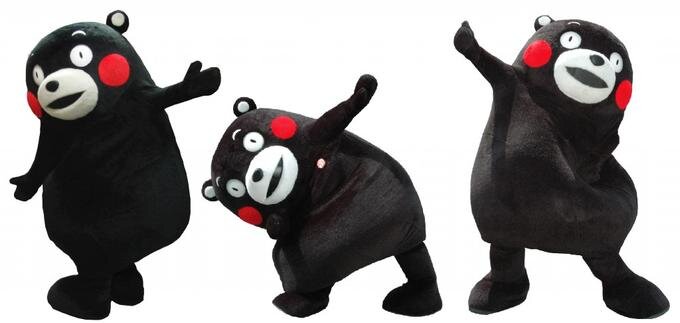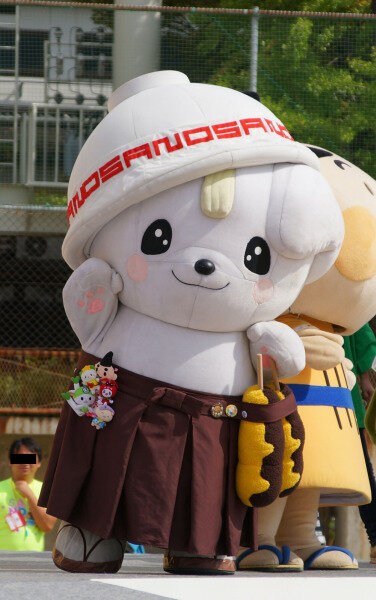Japanese Mascots & Kawai Chopsticks
In Japan we have yuru-kyara (mascot characters), they are the cute symbols of cities, towns, districts, or even buildings. They represent everything from sports teams, governments, police, prefectures … there are cute mascots everywhere in Japan. Many mascots have their own specific characteristics with specific likes and dislikes. They have their own social media accounts, fan clubs, and merchandise as well. Here are some of our favourites:
Domo-kun is one of the most recognizable mascots in and out of Japan. Domo-kun was first shown in a stop-motion cartoon in 1998 by NHK, Japan’s main main broadcasting agency, for its 10th anniversary and everyone loved the character so much, he remained as their mascot. Domo-Kun’s has a large saw-toothed mouth that is locked wide open and lives in a cave with its friends. Domo also farts often and sweats a lot when he is nervous or upset. Domo-Kun can’t speak normal languages and uses a form of grunts and roars to communicate. His favorite food is nikujaga, a Japanese meat and potato stew. Domo has many friends with interesting characteristics.
Domo lives in a cave with Mr. Usaji, known as Usajii (うさじい), a portmanteau of the words usagi (rabbit), and jii (old man, grandpa). Mr. Usaji is a wise old rabbit who has lived in a cave for decades, loves to watch television and drink green tea. Mr. Usaji is not into any "new" materials, and does not own a telephone In terms of fashion, Mr. Usaji focuses on materials instead of shapes. Mr. Usaji's favorite food is carrots, and his least favorite food is "something that is meaningless."
Also in the cave live two bats, a mother named Maya and her child Morio . Maya suffers from alchoholism; her favorite foods are seasonal while her least favorite food is alcohol. Mario's favorite food is Japanese-style tomato spaghetti, while his least favorite food is shitake mushrooms.
The other main character in the shorts is a weasel girl named Tā-chan, a 17 years old weasel who aspires to be a fashion stylist or model in Tokyo and is always using technology (televisions, mobile phones, and cameras). She has not had a boyfriend in ten years and she is seeking a platonic boyfriend. She has a passion for bidding in auctions, but she gives up by the end. Tashanna's favorite food is apricots and mint tarts, and her least favorite food is sea urchin
Bear Boy (Kogumagorō, also known as A Little Bear) is a Moon Bear and one of Domo's friends from the neighborhood; the timid cub enjoys playing baseball.
Hee and Haw are pixie twins from one flower. Domo is the only individual who can see them.
The Fox Trio consists of Esuko, Brother Fox Aniki-chi, and Fox Boy. Esuko, the youngest member, enjoys making crocodile tears, plotting schemes, and causing havoc. Brother Fox, the eldest member, dutifully cares for his youngest siblings and feels upset when referred to as "short-legged". Fox Boy, having a quiet demeanor, converses with Domo and Bear Boy and prefers to read.
Hungry Bear (Harapekoguma), a large and powerful bear, feels too hungry to take advantage of his strength.
The Ghost (Hyūtarou) randomly appears and disappears.
You can watch short films on the NHK website. It will make you smile.
If you like this character, we still have a few pieces at our store Bows & Arrows!
Kumamon:
Kumamon is a mascot created by the government of Kumamoto in 2010 and was voted as the best mascot in Japan in 2011. It was created in 2010 for a campaign created to draw tourists to the region after the Kyushu Shinkansen line opened. A large part of Kumamon's success can be attributed to its cuteness. The unusual marketing strategy of free licensing is also behind Kumamon's commercial success, since the Kumamoto prefecture grants usage rights for free to anyone as long as their products promote goods and services from the prefecture. The Bank of Japan estimated that Kumamon, Kumamoto’s adorable mascot, had pumped ¥123.2 billion into the region before his second birthday. Although he has a youtube channel, he doesn’t have many of the quirks of other mascots, likes & dislikes, etc. Although his story comes from history. Miyamoto Musashi — a legendary samurai who called this corner of Kyushu home in the 17th century — was Kumamoto’s most famous resident… until a black bear with bright-red cheeks swiped the swordsman off his throne. Kumamon has an office where he carries out his duties as Kumamoto’s manager of sales and happiness (his official title).
Barii-san:
Barii-san was created to be a guide for Imabari City in Ehime prefecture. Everything about this Japanese mascot is meant to represent the area it comes from. It is a chicken as the main food that the city is known for is yakitori, grilled chicken. He wears a haramaki made of cotton. Cotton is the main product of the city which has the largest towel making production in the country. his diadem is actually an invitation to visit the spectacular Kurushima-Kaikyō Bridge. Also, Barii-san holds in his hand a boat-shaped wallet, a hint to the local Imabari Shipbuilding, the largest ship builder in Japan.
Sanomaru:
Sanomaru is a dog, and also a samurai. He wears traditional clothes, a hakama style skirt and zori flip flops, with an upturned ramen noodle bowl on his head and “imo-fry”, potatoes fried in breadcrumbs, on a skewer, as his sword. Sanomaru embodies the city’s culinary specialties: Sano-ramen noodles and potato fries with a special sauce. Sanomaru was created to attract tourists to Sano, about 55 miles of Tokyo. The charming samurai also aims to promote unity among the three municipalities that joined forces in 2005. His personality is mischievous and gluttonous. His hobby is tasting the food of Sano prefecture. His weakness is not being able to remove the Sano ramen bowl from his head. His charm point is his cute bangs that are ramen noodles.
Melon Bear:
Melon Bear might be one of the most bizarre mascots in Japan. He represents the two main things that represent Yubari City in Hokkaido. When one would think of a bear that represents melons, you would picture a kind and welcoming animal, but the creators decided to go a different route. The bear design makes it look savage and ready to attack anyone who walks by it. One of the main aspects of the mascot is to run around and attack other mascots in the vicinity. The story behind the bear’s current appearance is that it had been eating locally grown melons and was altered into its current form. It isn’t the official mascot of the city, but it has gained in popularity and has become a well-known mascot in the country.
Namazu:
Namazu is derived from an old Japanese myth. It is a giant catfish that sleeps in the mud under the earth. It is guarded by the god Kashima who restrains the catfish with a large stone. When Kashima lets his guard down the catfish begins to writhe around and cause earthquakes. This mascot will come out during preventative events or when there are earthquake drills in major areas. You can see pictures of the catfish on signs that warn you of earthquakes and where to go if there is a disaster.
Prefecture Police mascots complied by Edward Harrison :
Miyagi-kun from Miyagi prefecture is a wild goose and the Miyagi bush clover are two symbols of the prefecture and are incorporated into their mascot. Miyagi-kun holds the clover in his hand which acts as an antenna for his radio.
Hikaru-kun & Hikari-chan: Koshihikari a popular variety of rice cultivated in Japan is the subject of Niigata’s pair of mascots. The Koshihikari produced in Niigata is considered by many to be the best rice in the world so these mascots are of course, rice grains.
Tateyama-kun: Designed by Fujiko Fujio (the pen name for two manga artists called Hiroshi Fujimoto and Moto Abiko). Most famous for creating Doraemon and Obake no Q-taro they both came from Toyama. The design and name of the character comes from Mount Tate one of the tallest peaks in Toyama.
Ryupi-Kun: Fukui prefecture is the location for Japans only dedicated dinosaur museum and considered one of the best in the world. Fukui is also the location for the Kitadani Dinosaur Quarry, where many interesting discoveries have been made. His name combines the word kyourue which means dinosaur and pi which stands for police and people.
Konohakeibu: The bird symbol of Aichi is of course an owl, a Eurasian scops-owl to be precise which is called ‘konohazuku’ in Japanese. Shinshiro in Aichi is a famous spot where the calls of the owls can be heard. So the first part of the name comes from the type of owl while the later, ‘keibu’ means police inspector.
Sento-kun isn’t Nara’s only deer inspired mascot. The city famous for the deer that roam through the town and park. Legend says the mythological god Takemikazuchi arrived in Nara riding a white deer to guard the newly built capital of Heijō-kyō. Since then the deer have been regarded as heavenly animals, protecting the city and the country. Napo-kun’s name comes from abbreviating the two words Nara and police.
Fukumaru-kun: One of the prefecture symbols of Yamaguchi is the fugu. Shimonoseki a city in Yamaguchi is known as fugu city and supplies a large part of Japan with the toxic delicacy. It was also the first city to lift the ban on fugu sales during the Meiji period. The fugu can inflate its body several times it’s normal size and of course can poison it’s predators. In Yamaguchi they call the fish ‘fuku,’ which means ‘to blow’ or ‘happiness.’ ‘Maru’ the second part of Fukumaru’s name means circle.
Gorou-kun: ‘Mutsugorou’ is the Japanese word for mudskipper and where Gorou-kun takes his name. The wide eyed mudskipper a creature common on the coast line of saga represents the friendliness of the police force, their sense of justice and cheerfulness.
Kawai Chopsticks:
"Tetoca" chopsticks by Kawai are made from trees bearing fruits including chestnut, persimmon, mandarine, and peach.
These chopsticks are coated with bees wax for a better protection. The bees wax is known as an eco friendly material, and it is gentle on the skin as well.
Wood: Chestnut, Persimmon, Tangerine, Peach.
Beeswax finish
Please visit Bows & Arrows to see these chopsticks or visit our online store Here to view them.





















